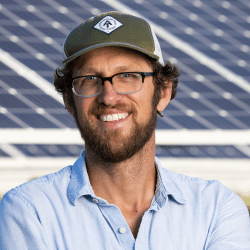Introduction
Saket Soni is building the systems of recognition, certification, and support for the growing labor force of resilience workers – the essential workers of the new climate change era.
The New Idea
The scale and scope of “billion-dollar [natural] disasters” triggered by climate change is increasing exponentially in the US and around the world. Saket Soni notes that, “this is America’s new normal, and we’re not prepared for it.” While we can’t currently prevent hurricanes, wildfires, tornadoes, and severe storms from wreaking havoc, he believes we can alleviate immeasurable suffering and even emerge more resilient in the face of future climatic threats. How? By building a powerful and permanent resilience climate workforce, the likes of which has never been seen before in the U.S.
What we have now is a workforce that is vulnerable and temporary. This country already relies upon a largely invisible, transitory workforce that responds to and rebuilds after extreme weather events. As climate-related disasters increase in frequency and severity, demand for this workforce has grown exponentially. But because these workers are majority undocumented and unprotected, they are vulnerable to exploitation within the chaotic disaster response industry, which lacks standards and rewards bad actors.
Saket Soni is protecting, expanding and improving the capabilities of this workforce to meet the urgent needs of our new climate change era. Like the growing numbers of “gig-economy workers” today, these workers don’t share a shop floor or consistent employer. But unlike Uber drivers and “task rabbits” that organize by signing online petitions and by putting pressure on their current employer -- Saket has created a whole new way to organize around an underutilized set of levers. To do this, Saket first created a new type of hiring hall – re-imagining one of the oldest and most powerful tools available to unions in achieving the bargaining strength necessary to win improvements in employees’ wages, hours, and working conditions. Whether in a Home Depot parking lot or on a Whatsapp thread, Saket is transforming the tools of labor organizing for the gig economy and the climate future. And secondly, he applies additional outside leverage to the employers by working with federal, state, and municipal funding streams and procurement processes.
Then, if we can build interdependence and a shared value of resilience among those actors, this becomes an inherently durable, replicable, game-changing opportunity. Indeed, when we have a permanent climate resilience workforce, we all win. Not only do more people have more secure and safe jobs, but cities themselves are more stable. When not responding to storms, skilled technicians are shoring up infrastructure, and in the aftermath of severe weather events residents of cities that are better prepared bounce back more quickly (sending kids to school, supporting local businesses, and paying local taxes).
By revaluing this essential workforce, updating powerful labor organizing tools for the modern era, and collaborating with key partners in government and industry, Saket is rewriting the rules of disaster recovery with resilience at its core.
The Problem
The National Oceanic and Atmospheric Administration noted a new U.S. record in 2020: a total of twenty-two “billion-dollar disasters” in one year. In contrast, in 2001 there were just two such events; in 2010 only seven. Weather and climate disasters are on the rise, and Americans are not prepared. Saket puts it in more stark, human terms: today, “hundreds of millions of Americans live in homes and cities that will not survive the next climate disaster – the storm that could come anytime.”
Our current “solution” is to rebuild, rebuild, rebuild, hence why these disasters are commonly measured by the cost of cleaning up, versus the lives lost (600+ last year) or communities changed. The insurance industry paid out at least seventy-six billion dollars for repairs after the 2020 storms and fires, and the government paid more than a hundred billion.
Some of the rebuilding costs are for cement and rebar. But a lot of it is for labor costs. Much of that money flows to multinational corporations that, working though subcontractors and labor brokers, rely on a vast and rapidly growing group of workers who are instantly mobile, open to arduous work, and –therefore – inherently vulnerable. That these essential and often invisible and undocumented workers are being exploited is what Saket Soni refers to as the “labor crisis tucked within the climate crisis.” Some of this is work any able-bodied person can do, like sawing up fallen trees and clearing roads and power lines. But so much requires deep skill. Not just willingness to face risk and danger, but skill. For example, insurance companies are paying millions to raise homes on stilts, lifting entire homes 8-10 inches off the ground. There are crews that can do that four times per day. But too often we think of these jobs as menial and easy. In northern California, where last year 3,000 homes and schools were partially or fully destroyed by wildfires, there was a lot of work to do to get folks fed and hand out bottled water. Naturally, many of these first responders are volunteers. Volunteers might be okay sleeping in their cars for a weekend, but when the skilled workers are on the job months later and still packed six to a motel room, and during Covid outbreaks no less, the lines between anything-goes, all-hands-on-deck disaster response and sustaining and supporting a long-term recovery get blurred. Workers – who may also experience wage theft, harassment, injuries or injustices on the job, and more – are overlooked and exploited. As Saket sums it up, “imagine if all US hospitals were staffed either by untrained church volunteers or by trained but leased-for-a day nurses and doctors who lived in their cars. That’s how American disaster recovery is carried out today.”
But the workers aren’t suffering alone. On top of the pain of the workers who are low paid and unprotected there’s the pain of the renters and homeowners who are displaced but can’t get their homes fixed because of extraordinary worker shortages, and the pain of the city leaders whose communities have fled (and whose tax bases has dissipated). This is how Saket sees it: “However heroic the efforts of current resilience workers, every mayor in every disaster-stricken town will tell you that there aren’t nearly enough of them. That’s bad for homeowners who are waiting to come home, businesses that are desperate to reopen, and mayors who need to avert a vicious cycle of property abandonment, disinvestment, and tax base collapse. Without a robust resilience workforce ready to work year-round, entire communities are at risk.”
The urgent nature of recovery work, the shortage of workers, and the billions of government dollars that flow in the immediate aftermath of disasters has created a perfect storm. Disaster repair work has been outsourced to a chaotic and fissured labor contracting industry, without the basic protections that a critical and growing workforce needs, and markets have rewarded bad actors among the large companies, while paying living wages or offering more protections are disincentivized. When the going rate for day-labor from Sonoma is $25 per hour, the contractor that wins the bid is the one who brings someone in from Alabama willing to work for $11.
In the era of climate-change fueled natural disasters, Saket believes we can’t just repair. We need to prepare. And that means not just more workers but a foundation upon which one of the most critical new labor workforces can be sustained and thrive at scale. As Saket puts it, what we need is “to build the millions-strong, skilled, at-scale Resilience Workforce that America needs to face its climate future.”
The Strategy
Saket moved to New Orleans in 2005 shortly after Hurricane Katrina struck. Overnight, thousands of locals went from doing yard work to getting local disaster recovery contracts. Today, 17 years later, many are still crisscrossing the country working more than ten hurricanes and tornadoes per year.
In 2017 Saket launched a national organization that essentially follows these now seasonal workers and helps them to fight wage theft, avert injury, and generally prevent the kinds of disasters-within-disasters that pervade the industry. (Most of the workers are undocumented immigrants.) Saket and his team have won many legal battles over the years and become the de-facto watchdog org for this emerging sector. But Saket felt that Resilience Force’s fight wouldn’t be won by suing one company at a time; a larger intervention was needed.
Saket felt that the treatment and pay these workers were receiving was unfair, but he kept thinking that the way they were viewed more broadly also wasn’t fair. Amongst the many people he and his team worked with – to fight for stolen wages or negotiate better terms – he sensed a commitment to cause, and a calling. “Inside this group, a vocation is growing. This is sacred work. Older people bring young people in, dads bring in their kids. Extended networks come in. [The resilience workers I know] believe that this work is making them better people.” So not only did Saket want to do something more than fight company by company; he wanted to somehow show that this is essential, civic soul work, even though it’s currently invisible and deeply underappreciated. He needed to help usher in a societal mindset shift and reappraisal of value.
Allow him to explain. “Many are aware of the idea that when you own a house, at certain points you can re-appraise the value of the house. We want to re-appraise the value of these workers, most of whom are poor people of color.” Currently value is appraised in superficial ways. Because they are day laborers, and the link to their employers is casual, and because presumably many more would eagerly take their spot, any and all are offered the same, low “going rate.” Rarely are individuals recognized for their unique skills or training. It’s common for labor brokers to recruit workers in the parking lots of lumber yards like Home Depot. At one such site in LA, when asked “What do you do?” by the broker, Saket noted how many of the men replied “Todo!,” Spanish for “all” and essentially meaning “full service.” These men were willing to go into waterlogged or burned houses, remove the debris, remove the human remains, clean up the electrical to make the site safe, and fix the roof. Then they tear out damaged walls, hang fresh drywall, tape, spray, paint, and do whatever else is necessary to bring the house back to code. “Doing ‘it all’ is a term of art, and captures their value,” says Saket. Inside the single word “todo” are 40-60 crafts, all contained in one worker. One worker who too many people believe should be happy to work for less than a living wage.
So how to reappraise that value? In an adjacent field, healthcare, not too long ago “helpers” became recognized and certified as Registered Nurses. Today buildings can be certified as LEED or businesses as B-Corps. It’s out of this playbook that Saket and a set of collaborators are organizing and validating the skills workers bring to the table, getting companies to embrace the standards, getting investors in those companies bought into the standards to avoid risk, and getting insurance companies to recognize certified, skilled labor when companies bill for it. While they work across the board, a strategic goal they’ve already achieved was to set the standards for this profession from the top, working with the Department of Labor to launch a formal professional category called Certified Restoration Technician (CRT). Then, when it comes to the federal agencies that move the most disaster recovery money, Saket’s goal is to get them to recognize and then take responsibility for the well-being of the workers who perform work through their public money and for Congress to attach these same labor standards to federal money flows. Governors, county officials, and mayors, especially in the places where disasters reoccur the most, have a particular role to play: they can host workforce training centers, and also ensure that local work done on their dime is carried out by trained and certified workers.
Over the last 2-3 years, Saket and his team at Resilience Force, the non-profit he launched in 2017, have organized more than 10,000 Resilience Workers into a national worker association and engaged with companies that make up 25% of the market in the hardest hit regions into a “high-road table” (essentially a shortlist of businesses that have earned Resilience Force’s endorsement for having trained or hired CRTs, which then sends signals across the sector as to what success in the new game looks like). Resilience Force has also already taken 2,000 workers through formal training and certification processes to earn their CRT.
Much of the work above is around getting folks bought in and values aligned. The rubber really hits the road at the local training centers, so Saket’s current focus is on setting up model training centers and pre-apprenticeship and apprenticeship programs to move people along a skill ladder towards the CRT certificate. Here they are modeling (and already laying the groundwork for replicating) a municipal hub model, starting in New Orleans and Sonoma County. Saket and his team’s goal is to help build Resilience Workforce Development Centers around the country to train and place 10,000 workers in dignified and well-paid disaster restoration jobs in the next five years.
These efforts are already gaining traction. Since the Department of Labor standards first appeared, he estimates 40,000 workers have seen their salary double – if not triple. This is certainly true for Brian Williams, whom Saket met outside a casino in Louisiana. His latest gig was a 9-week job manually moving cement. He was paid $7.25 per hour. Brian went to the training center, drawn to the promise of a guaranteed job. He’s now working for Signal, a large rebuilding contractor, making $15-20 per hour, based on the job. (And Signal is happy to pay him more than double his earlier pay; in fact, they submit his time to insurance companies at a reimbursement rate of $45 per hour.)
One of the things about Saket’s approach that caught the eye of Sara Horowitz, founder of the Freelancer’s Union and the Mutualist Society, was how responsive his model is to today’s labor landscape. The way forward is not to organize around collective bargaining as in the past, where many small employees found power in the face of their single employer. For Sara, the fluid and changing nature of work calls for a new approach to labor in general, and the fluid and rapidly changing AND increasingly high stakes nature of climate resilience and disaster response work makes it especially important in Saket’s space. So the fact that Saket’s approach doesn’t just organize antagonistic workers but engages them, employers, and government alike in a new “hiring hall” model is a key distinction, and distinct advantage.
Other things on the horizon for Saket include helping update the rules of recovery for the climate era and helping ensure that the new businesses that emerge in this sector can create wealth for their workers (or better yet, are worker-owned cooperatives!). Regarding the former, Saket points out that “the [current] American rules of disaster recovery were written by Congress in 1996, based on a river flood in Pennsylvania. Those rules were adequate for that disaster’s scale and impact. But since then, climate change has spurred disasters and scaled destruction well beyond Congress’ imagining in 1996.” When the time comes, Saket will be able to show how certified CRTs can and should be written into these plans, and how budgets and plans should factor in the work of preparing for future climate shocks and not just rebuilding after disasters.
At the highest level, Saket’s hope is to re-stitch social cohesion in this country. In many other countries and throughout history, social movements have taken responsibility for social cohesion beyond their issue or constituency. With just a few exceptions (Saket lifts up Ai-Jen Poo’s work with the National Domestic Workers Alliance as an amazing outlier) this hasn’t happened in the US, where social movements focus narrowly on rights-based issues they want to win, creating lots of losers in the process. Saket thinks we can all win. In ten years, he envisions a diverse American Resilience Force one million workers strong, working on climate adaptation year-round, and deploying to disasters when needed. This force will not only build resilient homes and cities. It will build wealth for the workers who join. And it will build social cohesion by offering millions of diverse Americans a lived experience of solving problems together.
The Person
Saket grew up in New Delhi and attended school in a “swirl of social forces,” where young people were cast as protagonists in a world of possibility. At the age of 19, Saket arrived on a scholarship in Chicago to study English literature and theater. He graduated in 2000, right before 9/11 and the subsequent crackdown on foreigners. Because of a minor blip in his immigration paperwork, Saket became undocumented, unemployed and unhoused. He worked low-wage jobs and ran a theater company producing stories that centered the immigrant experience. Despite the difficulty of the political climate at the time, he was committed to staying and helping to rebuild democracy in America: “That early experience probably taught me to imagine a future even when there was no evidence that one was forthcoming – my own future in America.” His experiences as an undocumented worker and artist were fused during this trying period, and when he emerged, he began working as a community organizer.
When Hurricane Katrina hit New Orleans in 2005, Saket was organizing with majority Black low-income tenants in Chicago, including many whose families had come North during the Great Migration, seeking opportunity while fleeing lynchings and racial terror. Saket watched coverage of New Orleans in shock and sadness. But what many of his clients saw on the same screen was a continuation of American history, not an aberration. As Saket listened to their stories, he decided he had to go to New Orleans.
What was to be a brief volunteer trip turned into a life-setting experience for Saket. He moved there for good shortly thereafter and stayed for 15 years. During those early years of tenuous rebuilding, Saket witnessed the ravages of unfettered disaster on marginalized communities and the slow, laborious, process of repair. It was in New Orleans that he was first introduced to the massive yet largely invisible workforce responding to disaster:
The rebuilders were migrant workers who arrived by the thousands—plumbers, roofers, electricians, carpenters, sheetrockers, drywallers, painters, arriving from as nearby as Texas and as far away as Brazil and Peru. They lived in tents, in their cars, in dilapidated homes, under the Claiborne bridge. At daybreak, they gathered for work beneath the statue of the Confederate general. Lee’s Circle was the hiring hub for jobs across the Gulf Coast. Contractors would pull up in vans or buses, pick up day laborers, and drive them out to hurricane-torn places near and far.
Saket founded a local worker’s center and began organizing on behalf of migrant workers and displaced residents. After the intensive period of repair in New Orleans, Saket noticed that many of the workers had begun to follow disasters around the country, leaving their families to pursue temporary gigs in cities reeling from disaster. He started calling them “resilience workers” and began framing up a possible future for this critical workforce.
Saket’s strategic efforts and wide-angled vision bear the mark of his theatrical foundations. In a moment when a world defined by climate change is terrifying, if not impossible for so many people to imagine, Saket is not only laying the foundation for an adequate response to our certain future, but also encouraging the narrative and cultural shift required to move forward.




